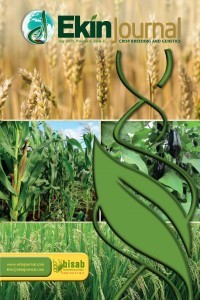Effect of Application of Increasing Nitrogen Rates on Tillering Characters of Triticale (xTriticosecale Wittmack) Genotypes
Effect of Application of Increasing Nitrogen Rates on Tillering Characters of Triticale (xTriticosecale Wittmack) Genotypes
___
- Alzueta I, Abeledo LG, Mignone CM and Miralles DJ (2012) Differences between wheat and barley in leaf and tillering coordination under contrasting nitrogen and sulphur conditions. Eur J Agron 41(1):92–102.
- Anonymous 2017. The Growth Potential of Triticale in Western Canada: Section B - Genetic Basis, Breeding and Varietal Performance of Triticale. https://www1.agric.gov. ab.ca/$department/ deptdocs.nsf/all/fcd4232.
- Anonymous 2018. How to Feed the World in 2050. http://www.fao.org/fileadmin/ templates/wsfs/ docs/expert_paper/How_to_Feed_the_World_ in_2050.pdf
- Dreccer F, Chapman SC, Rattey A, Neal J, Song Y, Christopher JT and Reynolds M (2013). Developmental and growth controls of tillering and water-soluble carbohydrate accumulation in contrasting wheat (Triticum aestivum L.) genotypes: can we dissect them? J. Exp. Bot. 64, pp: 143-160.
- Gill KS, Sandha GS and Dhinosa GS (1990). Germplasm evaluation and utilization in spring triticale, Proceedings of the Second International Triticale Symposium, 30-31.
- Gülmezoğlu N (2003). Eskişehir kuru koşullarında değişik azotlu gübrelerin, kışlık tritikalelerin çıkış, başaklanma, çiçeklenme ve olum süreleri ile verim öğeleri ve bazı kalite özellikleri üzerine etkileri, Osmangazi Ü. Fen Bilimleri Enstitüsü, Doktora Tezi, Eskişehir, 160s (In Turkish).
- Khaliq I, Parveen N and Chowdhry MA (2004). Correlation and path coefficient analysis in bread wheat. Int. J. Agric. Biol., 4:633-635.
- MSTAT (1984) MSTAT-C Microcomputer Statistical Program. Michigan State University. East Lansing, MI, USA.
- Rao ACS, Smith JL, Jandhyala VK, Papendick RI and Parr JF (1993). Cultivar and climatic effects on the protein content of soft white winter wheat, Argon. J., 85: 1023-1028.Reichenberger L. 2006. Tie nitrogen to tillering. http://www. needhamag.com/documents/ Tie_ Nitrogen_ To_Tillering.pdf.
- Şekeroglu N (1997). Van ekolojik şartlarında bazı yazlık triticale hatlarının verim ve verim unsurları üzerine farklı dozlarda azotlu gübrelemenin etkisi, Yüzüncü Yıl Ü. Fen Bilimleri Enstitüsü Yüksek Lisans Tezi, 45-51 (In Turkish).
- Üstünalp G (2010). Değişik ekim sıklıkları ve azot dozlarının tritikalede (x Triticosecale Wittmack) verim ve verim öğeleri üzerine etkileri. Namık Kemal Üniversitesi Fen Bilimleri Enstitüsü, Yüksek Lisans Tezi, 52 sayfa.
- Wang Y, J Lu, T Ren, S Hussain, C Guo, S Wang, R Cong and X Li (2017). Effects of nitrogen and tiller type on grain yield and physiological responses in rice. AoB Plants 9 (2):plx012. doi:10.1093/aobpla/plx012.
- Yanbeyi S (1997). Samsun ekolojik koşullarında bazı tritikale çeşit ve hatlarının verim ve verim öğeleri üzerine bir araştırma, Ondokuz Mayıs Ü. Fen Bilimleri Enstitüsü, Yüksek Lisans Tezi, 48 s.
- ISSN: 2149-1275
- Yayın Aralığı: Yılda 2 Sayı
- Başlangıç: 2015
- Yayıncı: Bitki Islahçıları Alt Birliği
Potential of Trakya Region for Production of Triticale
İsmet BASER, Zahit Kayihan KORKUT, Alpay BALKAN, Oguz BILGIN
Zinnur GOZUBUYUK, Okan DEMIR, Ahmet KUCUKOZDEMIR
Evaluation of Yield and Some Agro-Morphological Characters of Triticale Genotypes in Trakya Region
İrfan OZTURK, Turhan KAHRAMAN, Remzi AVCI, Sahinde SILI, Tugba Hilal KILIC, Adnan TULEK
Prospects of Advanced Genomics for Development of Climate Resilient Wheat Genotypes
Surender KHATODIA, Kirti BHATOTIA, Rishi K. BEHL
Emel OZER, Nurcan Akay GURBUZ, Nurdilek GULMEZOGLU
Seyma SARIBAS, Zuleyha CAKIR, Ahmet BALKAYA, Dilek KANDEMIR
Om Parkash BISHNOI, Suresh SURESH, Rishi Kumar BEHL
İsmet BASER, Zahit Kayihan KORKUT, Alpay BALKAN, Levent OZDUVEN, Oguz BILGIN
